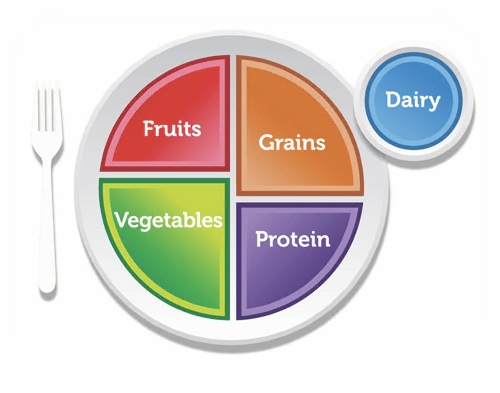USDA simplifies nutrition information for consumers
Catherine Margles is the owner of Las Vegas' Creative Cooking School and a chef/instructor there. But she's also the mother of sturdy 3-year-old twin boys, and she has always found the United States Department of Agriculture's Food Pyramid to be not much help in planning their meals.
"It was confusing, in that how do I know -- if I'm 2 years old or 92 years old -- what exactly I am supposed to use?" Margles said. "It had these lines, and who knew what the percentages mean, and everything like that? I can understand the frustration of mothers out there. What am I supposed to feed my family?"
Joanna Gorman is a registered dietitian at University Medical Center, but even she didn't have much use for the pyramid, and neither did her patients.
"They didn't even know about the pyramid," she said. "I don't teach it, because I hated it. It didn't really say anything."
The frustrations of both Margles and Gorman may be resolved, with the June 2 unveiling of MyPlate, the USDA's latest dietary guideline schematic.
Las Vegas resident Michael Ty, owner of MT Cuisine food-consulting group and national president of the American Culinary Federation, was in Washington, D.C., for the announcement with first lady Michelle Obama, Agriculture Secretary Tom Vilsack and Surgeon General Regina Benjamin.
"I think it's very simple," Ty said last week. "It shows a portion of a plate -- how much you should eat. I think it's a better guide."
The Food Guide Pyramid was introduced in 1992 as a tool to help Americans understand their dietary needs. It was divided horizontally and vertically into sections representing appropriate components of a healthy diet. But several things about it were confusing, including the fact that fats were at the top, where they seemed to have a position of importance despite the fact that they occupied the smallest section of the pyramid.
That guide was replaced in 2005 by one that made even less sense to most people. It was divided vertically into colored sections, each keyed to a food group. A figure running up steps on the side of the pyramid indicated the need for exercise in conjunction with a healthy diet, but the pyramid itself didn't provide much information.
MyPlate is exactly that -- a plate -- with one half labeled "fruits" and "vegetables," the other "grains" and "protein," with "dairy" represented by a tumblerlike circle on the upper right. There's no mention of fats.
"Looking at the new MyPlate," Margles said, "at least it's something familiar: I need to fill my plate with 50 percent fruits and vegetables."
"It's really simple," Gorman said. "It's right there in your face, and it tells you exactly what people should have. I already have people coming in and looking at the plate and saying, 'Oh, I get it.' "
"You can take your plate and make it look like that," said Robyn Lew, a registered dietitian with Nevada Cooperative Extension. "It's hard to do that with the pyramid."
Lew pointed out that a wealth of information is available at the USDA website www.ChooseMyPlate.gov. There's information supplemental to the plate diagram itself. The home page notes -- twice -- that we should consume smaller portions, that at least half of the grains we consume should be whole grains, that fruits and vegetables should be varied, protein lean and milk low-fat (1 percent) or fat-free. It advises comparing the sodium content in prepared foods-- and choosing the lowest -- and drinking water instead of sugary beverages.
But Gorman said that while the plate is a big improvement, it still has some shortcomings.
"It doesn't have pictures of the food," she said. "Do people know what protein is? No. Do they know what healthy protein is? No. Do you know how many people come in and think mashed potatoes and corn are vegetables?"
Well, from a botanist's viewpoint, they are. But not from a dietitian's.
Gorman also said ethnic foods, such as tortillas and beans, also aren't addressed, which can be confusing to people who don't know which groups they inhabit.
"What I would've done is put three or four pictures in the plate," she said. "Put the beans in with the meats. With the vegetables, put in carrots and green beans and lettuce and tomato -- to give people an idea. That's 90 percent of what we do."
Still, she said, "they've gone from being way too complicated to being simple. I like simple better than complicated."
Ty said the federation's upcoming national convention will have a focus on MyPlate and introducing it to the community.
"At the end of the day," he said, "it's the consumer that has to embrace it and say it's going to work."
Lew agreed that MyPlate won't do any good if people don't follow its advice.
"If they stick to the plate now and use it," she said, "I think it'll be great."
Contact reporter Heidi Knapp Rinella at hrinella@review journal.com or 702-383-0474.
TIPS FOR HEALTHIER EATING
Balance calories
Enjoy your food, but eat less
Avoid oversized portions
Make half your plate fruits and vegetables
Switch to fat-free or low-fat (1 percent) milk
Make half your grains whole grains
Cut back on foods high in solid fats, added sugars and salt
Compare sodium in packaged foods
Drink water instead of sugary drinks
Go to choosemyplate.gov for more information






















